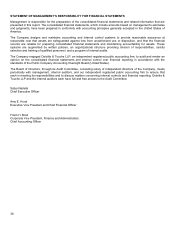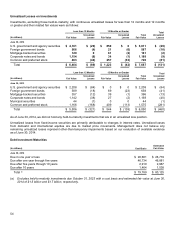Microsoft 2014 Annual Report Download - page 47
Download and view the complete annual report
Please find page 47 of the 2014 Microsoft annual report below. You can navigate through the pages in the report by either clicking on the pages listed below, or by using the keyword search tool below to find specific information within the annual report.
46
NOTES TO FINANCIAL STATEMENTS
NOTE 1 — ACCOUNTING POLICIES
Accounting Principles
The consolidated financial statements and accompanying notes are prepared in accordance with accounting principles
generally accepted in the United States of America (“U.S. GAAP”).
Principles of Consolidation
The consolidated financial statements include the accounts of Microsoft Corporation and its subsidiaries. Intercompany
transactions and balances have been eliminated. Equity investments through which we are able to exercise significant
influence over but do not control the investee and are not the primary beneficiary of the investee’s activities are accounted
for using the equity method. Investments through which we are not able to exercise significant influence over the investee
and which do not have readily determinable fair values are accounted for under the cost method.
Estimates and Assumptions
Preparing financial statements requires management to make estimates and assumptions that affect the reported
amounts of assets, liabilities, revenue, and expenses. Examples of estimates include: loss contingencies; product
warranties; the fair value of, and/or potential goodwill impairment for, our reporting units; product life cycles; useful lives of
our tangible and intangible assets; allowances for doubtful accounts; allowances for product returns; the market value of
our inventory; and stock-based compensation forfeiture rates. Examples of assumptions include: the elements comprising
a software arrangement, including the distinction between upgrades or enhancements and new products; when
technological feasibility is achieved for our products; the potential outcome of future tax consequences of events that have
been recognized in our consolidated financial statements or tax returns; and determining when investment impairments
are other-than-temporary. Actual results and outcomes may differ from management’s estimates and assumptions.
Recasting of Certain Prior Period Information
During the first quarter of fiscal year 2014, we changed our organizational structure as part of our transformation to a
devices and services company. As a result, information that our chief operating decision maker regularly reviews for
purposes of allocating resources and assessing performance changed. Therefore, beginning in fiscal year 2014, we
reported our financial performance based on our new segments described in Note 21 – Segment Information and
Geographic Data. We have recast certain prior period amounts to conform to the way we internally managed and
monitored segment performance during fiscal year 2014. This change impacted Note 10 – Goodwill, Note 14 – Unearned
Revenue, and Note 21 – Segment Information and Geographic Data, with no impact on our consolidated financial
statements.
Foreign Currencies
Assets and liabilities recorded in foreign currencies are translated at the exchange rate on the balance sheet date.
Revenue and expenses are translated at average rates of exchange prevailing during the year. Translation adjustments
resulting from this process are recorded to other comprehensive income (“OCI”).
Revenue Recognition
Revenue is recognized when persuasive evidence of an arrangement exists, delivery has occurred, the fee is fixed or
determinable, and collectability is probable. Revenue generally is recognized net of allowances for returns and any taxes
collected from customers and subsequently remitted to governmental authorities.
Revenue recognition for multiple-element arrangements requires judgment to determine if multiple elements exist,
whether elements can be accounted for as separate units of accounting, and if so, the fair value for each of the elements.
























